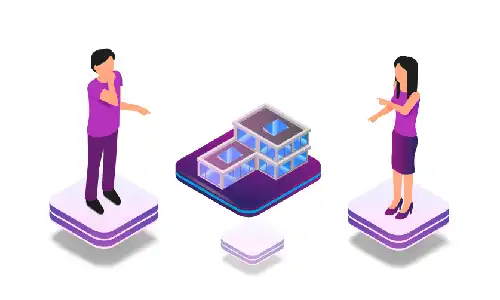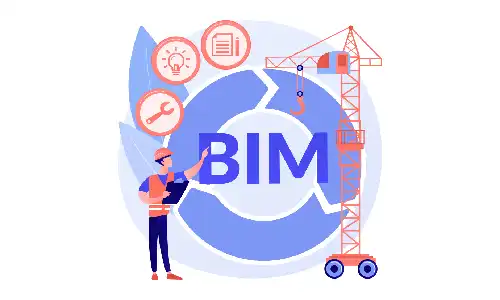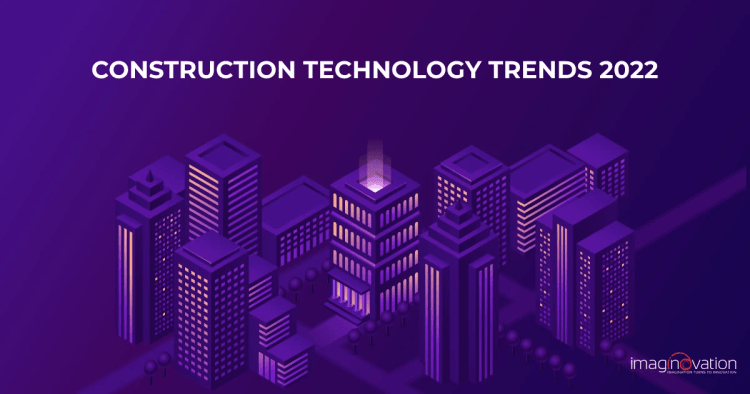Technological advancements are paving the way for digital transformation in the construction industry.
Today, there are numerous examples of how new technology is revolutionizing the construction sector.
Emerging technologies such as Artificial Intelligence (AI) and the Internet of Things (IoT) are helping construction companies eliminate long-standing inefficacies and low productivity.
New technologies are fueling the growth in construction. In this blog, we will take a look at some of the most promising construction technology trends in 2025.
But, before that let's take a look at what's causing driving the digitalization in construction?
Why is The Traditional Brick-and-Mortar Industry Reshaping?
So why is our traditional brick-and-mortar industry changing so fast?
The factors contributing to this change can be quite fascinating. They are quite a few in number, but they’re all significant in their own way, and influence the emerging technologies and how they’re used.

The construction industry and technology have several complementary facets, which include:
1. Rapidly Changing Client Expectations
Clients are micro-aware of the rapidly changing markets.
They have growing expectations for more innovatively tailored products for their homes, worksites, commercial buildings, and more. Client demands are quickly increasing.
Therefore, you can expect constructions to be more modularized, specific, and optimized on energy with more improved security and health parameters.
2. Powerful Capacities in Technology
New possibilities have cropped up in the construction industry. Sensors and the hardware and software connected to them are much more affordable now, and their increased adoption is doing wonders for the efficiency of your operation.
With new technologies in place, construction professionals can expect more novel and valuable transformations, backed by augmented reality and virtual reality (AR/VR), drones, robotics, and additive printing.
3. Burgeoning Start-up Environment
With new market opportunities that are induced by tech trends, start-ups are increasingly delivering valuable contributions.
Global management consultancy firm Oliver Wyman has identified over 1,200 start-ups in real estate and construction working since 2010, receiving over US$19.4 billion in funding.
4. Emerging Techies and New-gen Craftsmen
As construction professionals, you may be aware that the industry is fraught with resistance to change.
However, the sensibilities are changing. Modern-day professionals are tech-savvier, and more open to the new technologies the market has to offer. With emerging tech-related jobs, the younger generation has an exciting decade ahead to apply creativity to processes.
5. Supportive Legal Frameworks
With digitalization, there is an incredible opportunity to lessen the environmental impact of construction projects. Considering the fact the construction industry produces 38% of global energy-related CO2 emissions, the governments of the world are increasing their CO2 and energy efficiency regulations in regard to the industry.
You will find heightened requirements for data usage and cybersecurity in buildings and infrastructures.
As an entrepreneur in the construction industry, you will find the following decade is ripe with opportunities for innovation, augmentation, and a whole slew of new technological possibilities, ensuring success in the industry.
So, what are the digital technology trends in construction in 2025? Let’s find out.
Top Trends That Will Influence Construction Technology
Before we dive into the details of digital technology trends in construction in 2025 with examples, let’s take a sneak peek at some top trends that you can expect as influencers in construction technology.
According to the McKinsey report, here are some significant influencers.
1. HD Surveying and Geolocation
Projects typically get delayed because of discrepancies in ground conditions.
New techniques that incorporate high-definition photography, 3-D laser scanning, geographic information systems, and more can improve accuracy and speed.
2. 5-D Building Information Modeling (BIM)
BIM is a digital representation of the characteristics, including physical and functional aspects of a project, which forms a reliable basis for decisions during the project’s life cycle.
With the use of 5-D BIM technology, augmented reality (AR) technology via wearable devices can be further enhanced, which will transform the construction industry
3. Digital Collaboration and Mobility
Digitizing workflows has substantial benefits.
Digital solutions for construction need to deliver a seamless real-time experience across facets, such as design management, materials management, scheduling, QC, crew tracking, and more.
4. IoT and Advanced Analytics
In the construction industry, the IoT can allow construction machinery, equipment, materials, structures, and more to talk to a central data platform.
Other technologies, including sensors and near-field-communication (NFC) devices, can monitor productivity and reliability.
5. Future-proof Design and Construction
Building materials represent a $1 trillion global industry. New building materials, such as aerogels, self-healing concrete, and nanomaterials, can lower costs and also speed up construction, improving quality and safety.
As a construction professional, you’d be interested in knowing how to transform the construction processes using new tech trends successfully.
As CEO of Arabian Construction Company Maher Merehbi says:
In construction, innovations, and improvements are dynamic and happen quite frequently.
So, you can look forward to incorporating trending innovations, and the McKinsey report has already put forth some of the most exciting trending technologies.
Here’s a roundup of the digital technology trends for the construction industry in 2025 with examples.
Construction Technology Trends: 7 Futuristic Ideas & Examples

1. Augmented Reality (AR)
Augmented reality and virtual reality are making ripples across the construction world.
While AR superimposes a computer-generated image on a user’s view of the world, VR can replace the real world through a simulated environment.
However, AR is quickly taking over as an emerging trend with its benefits and uses over VR in the construction arena. Already in 2019, the industry share was at $9 billion, and, by 2030, it is estimated it will grow to a staggering $150 billion.
Imagine the power of visualizing the real world through a camera lens. AR systems can display critical information about equipment while the user can look at components or see display warnings when there are risks nearby.
For example, the user can get alerts through the AR lens that can “paint” surfaces if they’re experiencing high temperatures or are harboring an electrical current to avoid injuries.
As buildings are becoming increasingly complex, both AR and VR can facilitate in detecting design and coordination errors.
AR can also present BIM data through a next-generation visual platform, which could help in fostering coordination between consultants, designers, and construction teams. So, AR can also be used to discuss projects with clients.
For example, if you have a vacant site, then a completed project can be overlaid on the empty site so that the client can visualize the final result.
Construction professionals can look at new opportunities for the industry, even though they could come at a cost.
2. Building Information Modelling (BIM)

Another hot construction technology trend is BIM that promises to bring more accuracy to the building process.
BIM will prove to be a game-changer for the construction industry with its ability to depict project development in an open and highly collaborative environment.
The technology offers several benefits to construction companies. It makes resource management more accessible, enables enhanced collaboration, and helps people stay in touch throughout the project.
The new technology allows you to tackle important challenges like budget overspending, QC issues, and project delays. You may come across the latest version called the 5D BIM, which provides shorter project cycles, project scope understanding, and an increase in productivity.
Leading names that have embraced the technology include the Dubai-based architectural firm Killa Design, which has been a pioneer behind some of Dubai’s most iconic buildings, such as the Museum of the Future.
Some of the top BIM software solutions available in 2025 include Autodesk BIM 360, Revit, Navisworks, Tekla BIMsight, BIMobject, and BIMx.
In 2025, considering all the benefits of BIM, you are certain to find an ever-increasing desire for implementation of this kind of technology.
3. Robotics
Don’t be surprised if you find robots showing up at your worksites! No, it would not be a sci-fi plot—but an inevitable reality.
You can expect robots to become a commanding force in the construction arena with their offering of precision and accuracy. The cost of robotics may be high at the beginning, but it will be well worth the benefits.
For example, you may witness robots laying bricks and tying rebar or completing man-operated construction projects.
With various types of robots, such as collaborative industrial robots and logistics robots, you can expect more extensive adoption of robotics in construction. So, get ready to embrace robots as they assist in tasks that would take a human worker more effort.
For example, robots lifting heavy objects and placing them in exact coordinates.
4. More Prefabrication, Modularization, and Eco-friendliness
You will witness a growing trend towards multi-trade prefabrication.
For example, In Dubai, construction professionals printed a 3D office building in around 17 days and spent two days on-site assembling it. You can expect prefabrication to save you money. As construction professionals, you can benefit from bulk discounts on materials.
Another added benefit is saving time. With its advantages, professionals have used prefabrication on some of the UAE’s most impressive projects, such as Dubai Mall and Dubai Opera.
Another exciting trend is off-site construction—a.k.a. Modularization, which is quite similar to prefabrication. With its promise of consistent quality and faster construction times, the technology can produce buildings that map up to their traditionally built counterparts.
Another great example, a precast house that was built in two days, which is in tune with the Saudi Arabian government stepping up efforts to accelerate innovation and increase homeownership in the kingdom. Modular concrete was used by a local company to build the property (one-story) in Riyadh.
So, progressive construction companies have already started implementing these strategies to run their operations. The standardization offered by the new technology helps to cut down on costs and lead times.
The added benefit of the techniques is that they are eco-friendly because when working on the construction, the extra materials can be easily recycled.
5. Self-healing Concrete
In 2025, you can expect to see self-healing concrete used on buildings, roads, and homes.
Imagine the use of new technology to work on concern areas such as structural deterioration and building cracks. Although, at a nascent stage, the technology could be an excellent solution for such pain points.
With 4.4 billion metric tons produced in 2021, concrete is the most widely produced and consumed material in the construction industry, making this technology something many companies across the world will be keeping an eye on as it develops.
6. Cloud and Mobile Technology
Cloud operating systems have already been in use in many industries. Today, with mobile devices leveraging cloud technology (anywhere, anytime), you can look forward to storing massive amounts of information, and sharing it instantly.
So, to remain competitive, you may find the need to use a cloud-based business phone system that can easily be accessible.
Cloud solutions can not only facilitate storing large amounts of data but also in making it accessible for project managers, keeping it secure in a remote location. Later, this information can be accessed by connected devices or by data analysis platforms.
So, powerful data processing and storage are just some of the benefits of cloud computing technology, but the latter can be critical for firms to meet their contractual obligations.
Cloud-based Collaborations in Construction Projects
Another dominant trend in 2025 is Cloud-based Collaboration. Effective communication is a prerequisite for the successful execution of any project, and construction projects are inclusive.
With construction projects featured with high fragmentation, and different teams having little or no synchronization, you can expect cloud-based collaboration solutions, addressing the gap efficiently.
With several project participants and teams widely dispersed, it is evident that the project complexity increases, and the key to success are effective project team collaboration.
According to a survey report, 87% of the construction industry stated that they were open to using cloud technology for their processes.
In 2025, you can expect developers, engineers, and contractors to easily integrate and manage their existing processes through a single, always-connected cloud-based platform. With cloud-based collaborations, you can also look out for real-time collaboration.
Cloud can help contractors to work on the same sets of data across the back office. And you will find projects running in real-time with accurate data and digitization, eliminating various manual tasks, saving time, providing greater cost flexibility, and improving profitability and productivity.
7. Drones

Drone technology is rapidly evolving, and many construction sites are heavily relying on the use of drones (a.k.a. unmanned aerial vehicles, UAVs).
Goldman Sachs estimates that businesses and government investment in drone tech would reach around $11 billion by 2021. When it comes to drone production, you can expect the commercial development of drones to reach about $10.9 billion by 2025.
And, the global drone industry is forecasted to grow by $21.01 billion during 2021-2025.
In the construction industry, the use of drones can facilitate in many ways.
For example, surveyors can survey a site in a fraction of minutes, which traditionally can take weeks or even months. With the advantage of saving time and money, and accuracy and precision, you will find more construction companies who will openly embrace the technology.
Another excellent example, in the UAE, the Abu Dhabi Municipality brought out a pilot scheme to use drones for monitoring engineering work on construction sites.
The system will test the drone’s ability to withstand harsh climatic conditions, which can help to identify the solutions of the technology to support work on the ground.
In 2025, you can expect some incredible digital solutions in the construction industry, so gear up to check out the latest trends and enjoy riding the waves of change.
An Experienced Technology Partner for Incorporating Digital Technology Trends
It’s great that as construction professionals, you are seeking trending digital technology solutions in your construction processes.
We can help you incorporate excellent digital tech solutions to stay ahead of the competition and for a seamless experience, saving you time and money.
We are an award-winning team of web and mobile application developers with vast experience in emerging technologies like AI and IoT.
Ready to build an app, but not sure where to start?
We've got you covered. Click the button below to get started.





